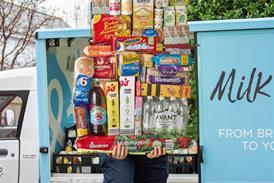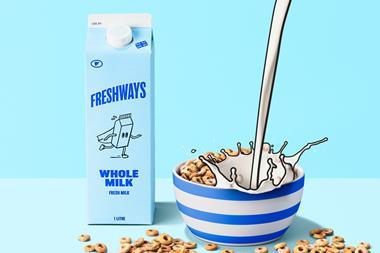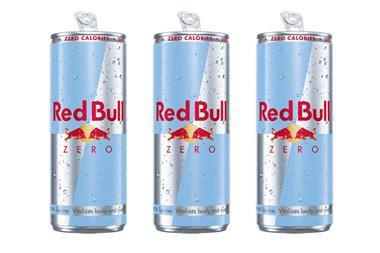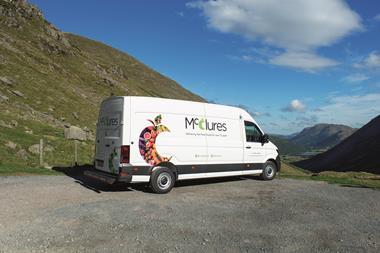Gary Hirshberg, CEO of Stonyfield Farm, said the launch of his £325m US yoghurt brand on to UK shelves in June last year would inject a sense of humour into the organic market. Now, less than a year on and with the products withdrawn, it is unlikely he sees the funny side. In fact, he's probably scratching his head wondering how a brand with such promise failed to appeal to UK consumers. And you can bet he isn't alone.
High-profile launches from Adez to Weetabix Gold have found themselves consigned to the great bargain bin in the sky in recent months, despite receiving the backing of multinational companies and some not insignificant marketing budgets.
So why have they failed to appeal? Is it the fault of the brand owners, the retailers, or both? And, more importantly, is there anything companies can do to reduce the risk of failure?
Rates of success in food and drink NPD do not make for happy reading. That nine out of 10 food and drink products fail within the first year of launch is well documented and companies can be excused for accepting failure as an unavoidable symptom of NPD.
With the cost of NPD failures potentially entering tens of millions of pounds, however, - Diageo backed Quinn's with an £8.5m launch, Hero's Fruit2Day had £11m put behind it and Unilever's Adez £12m - companies can't afford to be lackadaisical in their approach to innovation, says Tim Nicol, MD of product development consultancy Make Innovation Happen.
"As an industry, we should be aiming to get better odds than 10-1," he says. "The savings in effort, investment and product would be substantial."
According to Nicol, there are four criteria that a successful product must meet - it must fit a consumer need, fit the company's overall strategy, meet the brand's capability and be deliverable. Products fail, he says, because they meet some but not all these criteria.
Telling a company new products must meet consumer demand may sound akin to teaching a grandmother to suck eggs, but Nicol says many still overlook the basics. Products that lack consumer fit, for example, tend to have been produced because a company has developed new technology or manufacturing processes - not to meet customer demand. "There are many examples of products chasing the market or a company trying to find a home for new technology," he says. "Technology-driven ideas have a life of their own long before the consumer has been asked. It's a case of the men in white coats getting there first."
Launches also fail because they can't live up to the original brand. "Frozen puddings was a wrong move for Gü and was a stretch too far for its capabilities," according to one branding expert. "The company does chilled brilliantly but this didn't translate to frozen. A company can build brilliant brand equity in certain categories but find it is difficult to transfer it to others."
Weetabix Gold also failed to live up to its parent, the expert adds. "If you add a premium line under your own brand you run the high risk of having a detrimental effect on the parent brand. Gold was seen as a cynical attempt to charge more for something that was not very different."
Nicol also warns companies of what he calls 'concept creep', which is where a brilliant idea undergoes a series of minor alterations until it bears little resemblance to the initial concept and therefore fails.
"You make a number of small trade-off decisions individually - a different-shaped box or different ingredients - and each change doesn't feel that big. But in the end you find you have drifted a mile away from where you began. It is a common problem."
Suppliers themselves put failure down to similar reasons. Burton's Foods functional cereal bar Fruvo lasted less than a year and CEO Paul Kitchener admits it was ahead of the demand curve.
Stonyfield Farm, meanwhile, concedes it rushed its launch. "We should have built brand awareness and rates of sales before going mainstream," says Europe MD Matt Elder.
Unilever's soya drink brand Adez failed in the UK because the company overestimated demand for soya drinks, it says. Adez, which is hugely successful in Latin America, did not appeal to UK consumers, partly because they didn't understand it, says head of media relations Trevor Gorin. "We transplanted Adez into the UK but found people were generally not aware of the benefits of soya, or not as aware as we thought they were," he says.
"We were faced with a dilemma - do we pile on the resources to raise awareness of soya or do we spend the money elsewhere? We looked at what would get the most return on our investment and we decided to pull out."
But Unilever does not believe suppliers are solely to blame for the industry's poor NPD success rates. It lays some of the blame at the doors of the retailers, claiming their price promotions of new products often damage the chances of long-term success. Its Dove Summer Glow launch, in particular, was damaged by promotion, Gorin says, and the category is now "rubbished".
"What everyone has done is offer it on a price discount from minute one," adds Gorin. "But this needn't happen."
Gorin uses the launch of the iPod as an example. "For people who were predisposed to buying one when it was launched it made no difference if it was £250 or £300," he says. "They will spend the money because it is innovative. We want this to apply to commonplace fmcg goods. If you've got a truly new product, then you don't want to discount it straight away."
Nicol acknowledges retailers' role in NPD success or failure. "Retailers have influence over key decisions such as price, merchandising and shelf positioning, and so have a major role to play in the success of a brand," he says.
Promoting a brand from launch may not help. "The general rule of thumb is that if a product goes off like a rocket it is likely to come down like a rocket. It achieves high sales early by selling a lot of product for not very much but when the consumer returns and sees the price has doubled it is difficult to get them to buy again.
"Brands survive on repeat purchase, not continued trial."
Another critical factor is the length of time that retailers give a new brand to achieve success. Ideally it takes a couple of years for a product to be judged properly, says Nicol, but this is not usually the case - Stonyfield says it was given 16 weeks by Sainsbury's.
And Nick Smallwood, winner of the TV show Breaking Into Tesco, who launched his soup in a bun concept in the retailer earlier this month, says the product has six weeks to prove itself.
Simon Dunn, MD of sales and marketing consultancy Product Chain, is less convinced that promotion is an issue. "Manufacturers can't blame retailers," he says. "It's the retailers' job to get people in to buy products. A new launch will not fail just because it is promoted."
Dunn points to examples where promotions have helped a brand. He says that in 1996 Seagram, the then-owner of Tropicana, was considering axing the brand because UK sales were below 5,000 cases a week. "The product was put on bogof, sold in its thousands, and the rest is history."
If suppliers want success they are going to have to improve their approach to NPD, says Dunn, which is what Unilever, for one, is attempting. Stung by the withdrawal of Adez and by the decline of its Vie Shots range of drinks, which have also performed below expectations, Unilever has altered its NPD process.
In the past it took a standard innovation funnel approach to NPD, whereby thousand of ideas are filtered down based on their feasibility and the size of the opportunity they represented, rather than whether it was the kind of innovation the category wanted.
Now it has split its business into four segments - high-growth
markets with new opportunities, high-growth markets with few opportunities, mature markets with no growth and markets with small growth - with innovation tailored to each part.
"For good, growing categories and brands we look at differentiation. For more mature categories we look at supply chain innovation to be more efficient and make products cheaper," says Gorin.
It's a change that won't be lost on the retailers. "Retailers are aware of waste-of-time launches and are becoming less tolerant of them," says James Amoroso at independent food consultancy Amoroso.
"They are taking a jaundiced view of me-toos but are also keenly aware that innovation is the key to their success and are willing to listen to companies that are making changes to improve their NPD and that are driving true innovation.
"The next decade will be that of the serious product launch."nWhat Our branding experts say:
Adez
Date launched: May 2006
Date pulled: December 2007
"The soya drink market is still niche and there is a very narrow group of consumers who buy products based on allergies. Soya also has a poor taste perception and the combination of soya and fruit was seen to be unnatural. The name also didn't work in the UK - people didn't understand how to pronounce it ."
Birds Eye Pub Specials
Date launched: March 2006
Date pulled: June 2007
"Frozen food is a difficult area in which to grow value and while the Pub Specials range was a bold attempt, Birds Eye didn't give the range enough support. Frozen food has been heavily commoditised by the retailers and Pub Specials didn't offer consumers enough reason to believe they were getting something better ."
Gü frozen puddings
Date launched: May 2007
Date pulled: February 2008
"Frozen puddings was a wrong move for Gü . The company does chilled brilliantly but this didn't translate to frozen. Consumers want different things from the frozen category, namely value for money, but the Gü brand is all about premium indulgence. It was a brave effort but I think it was destined to fail because of this."
Heat to Treat
Date launched: March 2007
Date pulled: December 2007
"Microwaveable cakes are a bit confusing for consumers - they are neither for the convenience market nor for home baking . UB tried to inject some difference into the cakes category, which is commendable because NPD has historically been very poor, but these were products consumers had no need for."
Hero Fruit2Day
Date launched: January 06
Date pulled: October 2006
"The Hero brand is popular in Europe but has little heritage in the UK. It failed, in spite of an £11m launch, because as a drink containing lumps of fruit it was a difficult concept for consumers . It was pulled because Hero was not allowed to claim it contained two portions of fruit - something it should have checked first."
Potato Heads
Date launched: January 2005
Date pulled: September 2007
"Potato Heads performed brilliantly but lost their point of difference because they followed the trend for health that the Walkers brand moved into. Consumers are demanding low fat but Potato Heads constrained this to a kids product. After Walkers switched to healthier oil the brand was not as relevant."
Quinn's
Date launched: April 2006
Date pulled: June 2007
"This product looks like the result of producer push rather than consumer pull. Flavoured alcoholic beverages have been in long-term decline . Diageo talked about the drink in terms of its features - that it was alcohol derived from fruit - rather than its benefits, such as why should this appeal to consumers."
Ski Up & Go
Date launched: July 2004
Date pulled: November 2006
"This fruit yoghurt and cereal drink was a great idea but Ski was the wrong brand . Liquid food is a big category and this product was probably ahead of its time, but positioning was crucial. Nestlé maybe should have put it under one of its other brands or created a new brand for it. If it had I think it might still have been around."
Stonyfield Farm
Date launched: June 2007
Date pulled: April 2008
"This brand was given brilliant treatment, and it was differentiated from Yeo Valley and Rachel's Organic and from the US version. The company chose not to take a mass-market approach because the product is organic, but it then struggled against the bigger players."
Weetabix Gold
Date launched: July 2006
Date pulled: May 2007
"The product begs the question: what was wrong with the standard product? Although it used premium wheat it didn't taste very different and consumers wondered what justified the higher price. It was an attempt to go premium without offering anything extra."

















No comments yet